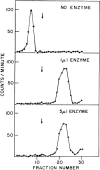How restriction enzymes became the workhorses of molecular biology
- PMID: 15840723
- PMCID: PMC1087929
- DOI: 10.1073/pnas.0500923102
How restriction enzymes became the workhorses of molecular biology
Abstract
Restriction enzymes have proved to be invaluable for the physical mapping of DNA. They offer unparalleled opportunities for diagnosing DNA sequence content and are used in fields as disparate as criminal forensics and basic research. In fact, without restriction enzymes, the biotechnology industry would certainly not have flourished as it has. The first experiments demonstrating the utility of restriction enzymes were carried out by Danna and Nathans and reported in 1971. This pioneering study set the stage for the modern practice of molecular biology in which restriction enzymes are ubiquitous tools, although they are often taken for granted.
Figures




Comment on
-
Specific cleavage of simian virus 40 DNA by restriction endonuclease of Hemophilus influenzae.Proc Natl Acad Sci U S A. 1971 Dec;68(12):2913-7. doi: 10.1073/pnas.68.12.2913. Proc Natl Acad Sci U S A. 1971. PMID: 4332003 Free PMC article.
Similar articles
-
Restriction enzymes and their use in molecular biology: An overview.J Biosci. 2019 Jun;44(2):38. J Biosci. 2019. PMID: 31180051 Review.
-
Danna and Nathans: Restriction enzymes and the boon to modern molecular biology.Proc Natl Acad Sci U S A. 2005 Apr 26;102(17):5909. doi: 10.1073/pnas.0502760102. Epub 2005 Apr 19. Proc Natl Acad Sci U S A. 2005. PMID: 15840710 Free PMC article. No abstract available.
-
The Nobel chronicles. 1978: Werner Arber (b 1929); Hamilton O Smith (b 1931); Daniel Nathans (b 1928).Lancet. 1999 Oct 30;354(9189):1567. doi: 10.1016/s0140-6736(05)76606-x. Lancet. 1999. PMID: 10551539 No abstract available.
-
[The Nobel Prize for Medicine and Physiology in 1978 (Werner Arber, Daniel Nathans, Hamilton Smith)].Ned Tijdschr Geneeskd. 1979 Feb 3;123(5):153-6. Ned Tijdschr Geneeskd. 1979. PMID: 368662 Dutch. No abstract available.
-
DNA Assembly Tools and Strategies for the Generation of Plasmids.Microbiol Spectr. 2014 Oct;2(5). doi: 10.1128/microbiolspec.PLAS-0014-2013. Microbiol Spectr. 2014. PMID: 26104347 Review.
Cited by
-
Using Structure-guided Fragment-Based Drug Discovery to Target Pseudomonas aeruginosa Infections in Cystic Fibrosis.Front Mol Biosci. 2022 Mar 30;9:857000. doi: 10.3389/fmolb.2022.857000. eCollection 2022. Front Mol Biosci. 2022. PMID: 35433835 Free PMC article. Review.
-
"French Phage Network" Annual Conference 2018-Fourth Meeting Report.Viruses. 2019 May 23;11(5):470. doi: 10.3390/v11050470. Viruses. 2019. PMID: 31126089 Free PMC article.
-
CRISPR-Cas9: A Powerful Tool to Efficiently Engineer Saccharomyces cerevisiae.Life (Basel). 2020 Dec 26;11(1):13. doi: 10.3390/life11010013. Life (Basel). 2020. PMID: 33375364 Free PMC article. Review.
-
An idea to explore: A systematic approach for solving plasmid double-digest puzzles.Biochem Mol Biol Educ. 2025 Jan-Feb;53(1):8-14. doi: 10.1002/bmb.21855. Epub 2024 Aug 2. Biochem Mol Biol Educ. 2025. PMID: 39092683 Free PMC article.
-
Restriction endonucleases that bridge and excise two recognition sites from DNA.J Mol Biol. 2007 Mar 23;367(2):419-31. doi: 10.1016/j.jmb.2006.12.070. Epub 2007 Jan 3. J Mol Biol. 2007. PMID: 17266985 Free PMC article.
References
-
- Smith, H. O. & Wilcox, K. W. (1970) J. Mol. Biol. 51, 379-391. - PubMed
-
- Danna, K., Sacks, G. H., Jr., & Nathans, D. (1973) J. Mol. Biol. 78, 363-376. - PubMed
-
- Nathans, D. & Danna, K. J. (1973) Nat. New Biol. 236, 200-202. - PubMed
-
- Lai, C. J. & Nathans, D. (1975) Cold Spring Harbor Symp. Quant. Biol. 39, 53-60. - PubMed
Publication types
MeSH terms
Substances
LinkOut - more resources
Full Text Sources
Other Literature Sources
Molecular Biology Databases

